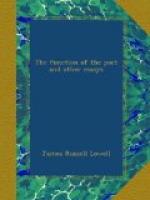It is curious to see how often Nature, original and profuse as she is, repeats herself; how often, instead of sending one complete mind like Shakespeare, she sends two who are the complements of each other,—Fielding and Richardson, Goethe and Schiller, Balzac and George Sand, and now again Thackeray and Dickens. We are not fond of comparative criticism, we mean of that kind which brings forward the merit of one man as if it depreciated the different merit of another, nor of supercilious criticism, which measures every talent by some ideal standard of possible excellence, and, if it fall short, can find nothing to admire. A thing is either good in itself or good for nothing. Yet there is such a thing as a contrast of differences between two eminent intellects by which we may perhaps arrive at a clearer perception of what is characteristic in each. It is almost impossible, indeed, to avoid some sort of parallel a la Plutarch between Thackeray and Dickens. We do not intend to make out which is the greater, for they may be equally great, though utterly unlike, but merely to touch on a few striking points. Thackeray, in his more elaborate works, always paints character, and Dickens single peculiarities. Thackeray’s personages are all men, those of Dickens personified oddities. The one is an artist, the other a caricaturist; the one pathetic, the other sentimental. Nothing is more instructive than the difference between the illustrations of their respective works. Thackeray’s figures are such as we meet about the streets, while the artists who draw for Dickens invariably fall into the exceptionally grotesque. Thackeray’s style is perfect, that of Dickens often painfully mannered. Nor is the contrast less remarkable in the quality of character which each selects. Thackeray looks at life from the club-house window, Dickens from the reporter’s box in the police-court. Dickens is certainly one of the greatest comic writers that ever lived, and has perhaps created more types of oddity than any other. His faculty of observation is marvellous, his variety inexhaustible. Thackeray’s round of character is very limited; he repeated himself continually, and, as we think, had pretty well emptied his stock of invention. But his characters are masterpieces, always governed by those average motives, and acted upon by those average sentiments, which all men have in common. They never act like heroes and heroines, but like men and women.
Thackeray’s style is beyond praise,—so easy, so limpid, showing everywhere by unobtrusive allusions how rich he was in modern culture, it has the highest charm of gentlemanly conversation. And it was natural to him,—his early works ("The Great Hoggarty Diamond,” for example) being as perfect, as low in tone, as the latest. He was in all respects the most finished example we have of what is called a man of the world. In the pardonable eulogies which were uttered in the fresh grief at his loss there was a tendency to set him




